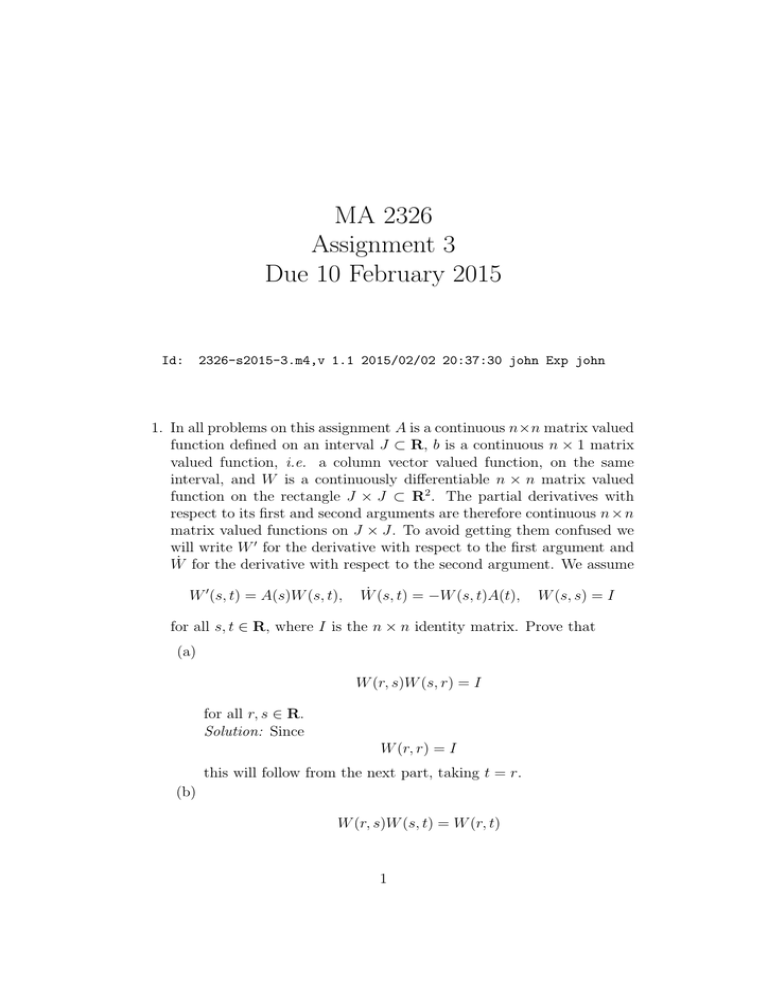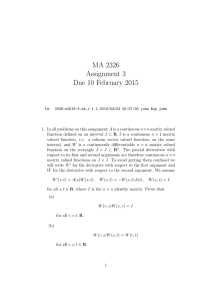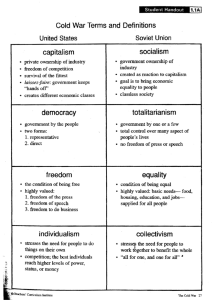MA 2326 Assignment 3 Due 10 February 2015
advertisement

MA 2326 Assignment 3 Due 10 February 2015 Id: 2326-s2015-3.m4,v 1.1 2015/02/02 20:37:30 john Exp john 1. In all problems on this assignment A is a continuous n×n matrix valued function defined on an interval J ⊂ R, b is a continuous n × 1 matrix valued function, i.e. a column vector valued function, on the same interval, and W is a continuously differentiable n × n matrix valued function on the rectangle J × J ⊂ R2 . The partial derivatives with respect to its first and second arguments are therefore continuous n × n matrix valued functions on J × J. To avoid getting them confused we will write W ′ for the derivative with respect to the first argument and Ẇ for the derivative with respect to the second argument. We assume W ′ (s, t) = A(s)W (s, t), Ẇ (s, t) = −W (s, t)A(t), W (s, s) = I for all s, t ∈ R, where I is the n × n identity matrix. Prove that (a) W (r, s)W (s, r) = I for all r, s ∈ R. Solution: Since W (r, r) = I this will follow from the next part, taking t = r. (b) W (r, s)W (s, t) = W (r, t) 1 Id: 2326-s2015-3.m4,v 1.1 2015/02/02 20:37:30 john Exp john 2 for all r, s, t ∈ R. Solution: Let C be defined on J × J × J by C(r, s, t) = W (r, s)W (s, t) and let Ċ be its derivative with respect to its second argument. Then Ċ(r, s, t) = Ẇ (r, s)W (s, t) + W (r, s)W ′(s, t) = − W (r, s)A(s)W (s, t) + W (r, s)A(s)W (s, t) = 0, so C(r, s, t) is independent of s. It follows that C(r, s, t) = C(r, r, t) = W (r, r)W (r, t) = IW (r, t) = W (r, t). Of course evaluating at s = t would have worked equally well. 2. Show that if the vector valued function y on J is defined by y(x) = W (x, x0 )y0 + Z x W (x, z)b(z) dz x0 where x0 ∈ J and y0 is a (constant) column vector then y ′(x) = A(x)y(x) + b(x), y(x0 ) = y0 . Solution: Substituting x = x0 gives y(x) = W (x0 , x0 )y0 + Z x0 W (x0 , z)b(z) dz. x0 W (x0 , x0 ) = I and any integral over an interval of length zero is zero, so y(x0 ) = y0 . Differentiating y(x) = W (x, x0 )y0 + Z x W (x, z)b(z) dz x0 gives y ′(x) = W ′ (x, x0 )y0 + Z x W ′ (x, z)b(z) dz + W (x, x)b(x) x0 = A(x)W (x, x0 )y0 + Z = A(x) W (x, x0 )y0 + = A(x)y(x) + b(x). x A(x)W (x, z)b(z) dz + b(x) xZ0 x x0 W (x, z)b(z) dz + b(x) Id: 2326-s2015-3.m4,v 1.1 2015/02/02 20:37:30 john Exp john 3 3. Show that if y is a continuously differentiable vector valued function on J satisfying y ′(x) = A(x)y(x) + b(x), then y(x) = W (x, x0 )y0 + Z y(x0 ) = y0 . x W (x, z)b(z) dz. x0 Note: You may use the results of earlier questions even if you didn’t succeed in proving them. You may find the quantity u(x) = W (x0 , x)y(x) − Z x W (x0 , z)b(z) dz x0 useful. Solution: The quantity u(x) is independent of x. To see this we just differentiate. The differentiation under the integral sign is easier than in the previous problem because the integrand is independent of x, so we can just use the Fundamental Theorem of Calculus. u′ (x) = Ẇ (x0 , x)y(x) + W (x0 , x)y ′(x) − W (x0 , x)b(x) dz = −W (x0 , x)A(x)y(x) + W (x0 , x)y ′(x) − W (x, z)b(x) = W (x0 , x) [y ′ (x) − A(x)y(x) − b(x)] = 0. It follows that u(x) = u(x0 ) = W (x0 , x0 )y(x0 ) − Z x0 W (x0 , z)b(z) dz = Iy0 + 0 = y0 . x0 Substituting the definition of u(x), W (x0 , x)y(x) − Z x W (x0 , z)b(z) dz = y0 . x0 Multiplying by W (x, x0 ) from the left, W (x, x0 )W (x0 , x)y(x) − Z x W (x, x0 )W (x0 , z)b(z) dz = W (x, x0 )y0 x0 or, in view of the identities from Question 1, Iy(x) − Z x W (x, z)b(z) dz = W (x, x0 )y0 , x0 from which it follows directly that y(x) = W (x, x0 )y0 + Z x x0 W (x, z)b(z) dz.





